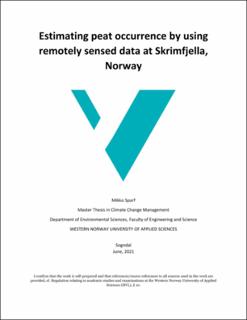| dc.description.abstract | Peatlands are undeniably an important asset in climate change management. Still, even today many of the natural peatlands in Norway are in danger of being dried in order to build new cabins, highways or wind parks. Traditionally, confirming peat occurrences can require some extensive fieldwork. Traversing the areas by foot has for long been the only method of locating new peat deposits in an accurrate way. This study aims to discover and confirm if remotely sensed data could be used to find new peat deposits reliably. Recently, LiDAR and radiometric (gamma-ray spectrometric) data have shown potential, and this is a first time researching peat occurrence in a study area with such a great variation in topography.
The characteristics of the study area in Skrimfjella inspired the predictor selection used in this thesis. 106 peat occurrence points and 123 added positive occurrence points (from peat depth measurements) were visited in the study area and examined in relation to the Digital Elevation Model-derived predictors: elevation, slope, topographic wetness index, heat index and aspect favorability. Additionally, the radiometric predictors uranium, thorium and potassium as well as the combination of these three were used for modeling of the relationships between the predictors and the occurrence points. Slope, topographic wetness index and elevation had the most explanatory value, while uranium was the most predictive radiometric predictor. The final model included these predictors and only had a sensitivity of 0.28, meaning that the model could only identify 28% of the existing peat. The specificity was 0.96, meaning that when the model identified peat, it was typically right. Model accuracy was 50%. The failure of the radiometric predictor performance could be traced back to the various bedrock types affecting the spectrometer measurements in Skrimfjella. The better performance of the topographic predictors not based on aspect, is likely due to the variable characteristics in the study area. With proper spectrometer calibrations and a decent sample size, using remotely sensed data for estimating peat occurrence has a great potential for peatland management and therefore, climate change mitigation. | en_US |

